COIT20275 CQUniversity: Perth Stadium System Design Process Analysis
VerifiedAdded on 2023/06/04
|13
|3131
|468
Report
AI Summary
This report provides a detailed analysis of the system design process of the Perth Stadium, focusing on the preliminary and detailed design phases. It examines the functional analysis, synthesis of design criteria, system and subsystem analysis, and evaluation of design alternatives. The report also delves into acquisition plans, program implementation, and supplier activities. Furthermore, it assesses the system test, evaluation, validation, and optimization processes, including simulation evaluations using tools like VISWALK. The analysis highlights the importance of considering factors such as public transport, pedestrian densities, and service levels to ensure the stadium's efficient operation and performance. The report concludes with an evaluation of the design's responsiveness to Western Australia's climate conditions and the overall success of the project.
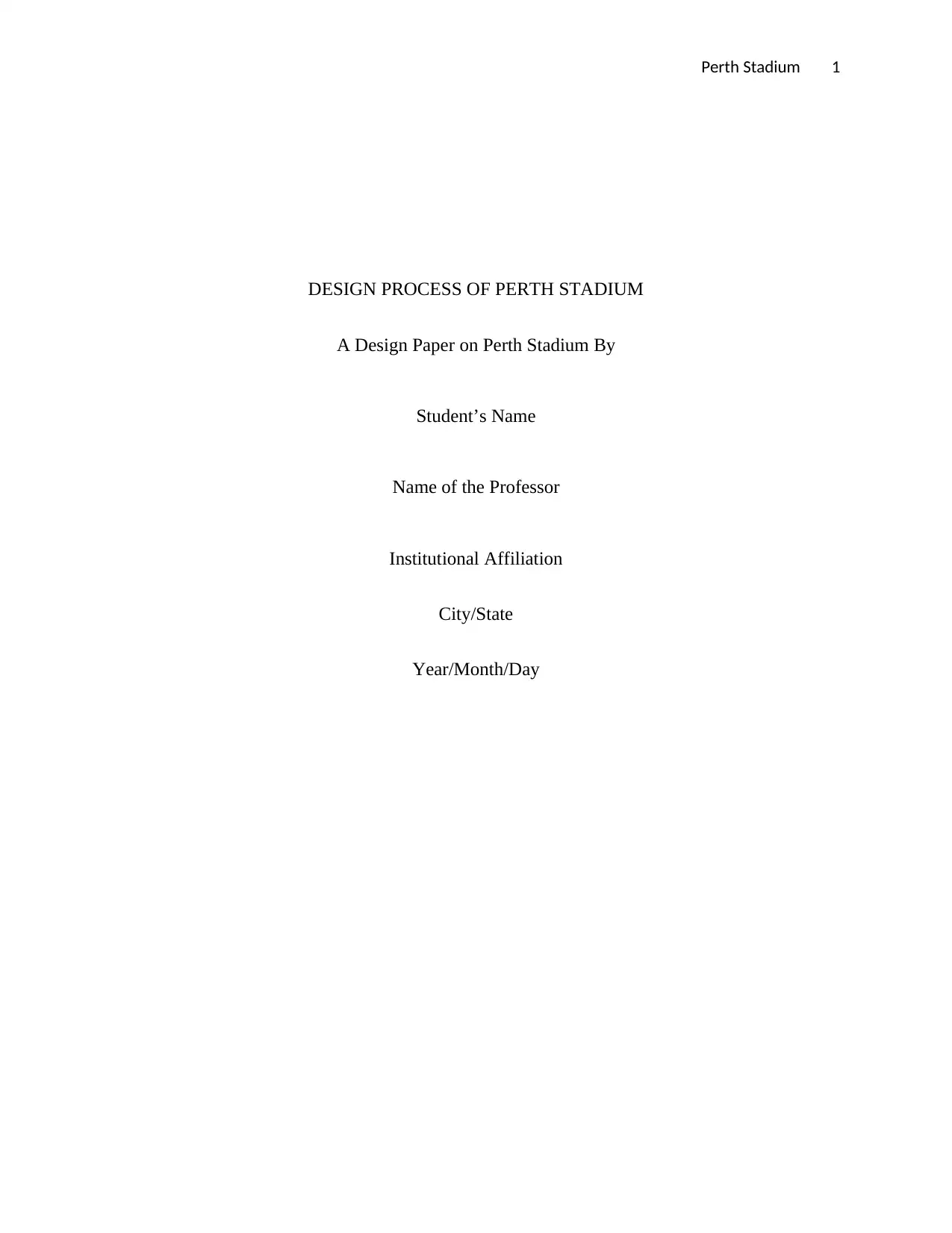
Perth Stadium 1
DESIGN PROCESS OF PERTH STADIUM
A Design Paper on Perth Stadium By
Student’s Name
Name of the Professor
Institutional Affiliation
City/State
Year/Month/Day
DESIGN PROCESS OF PERTH STADIUM
A Design Paper on Perth Stadium By
Student’s Name
Name of the Professor
Institutional Affiliation
City/State
Year/Month/Day
Paraphrase This Document
Need a fresh take? Get an instant paraphrase of this document with our AI Paraphraser
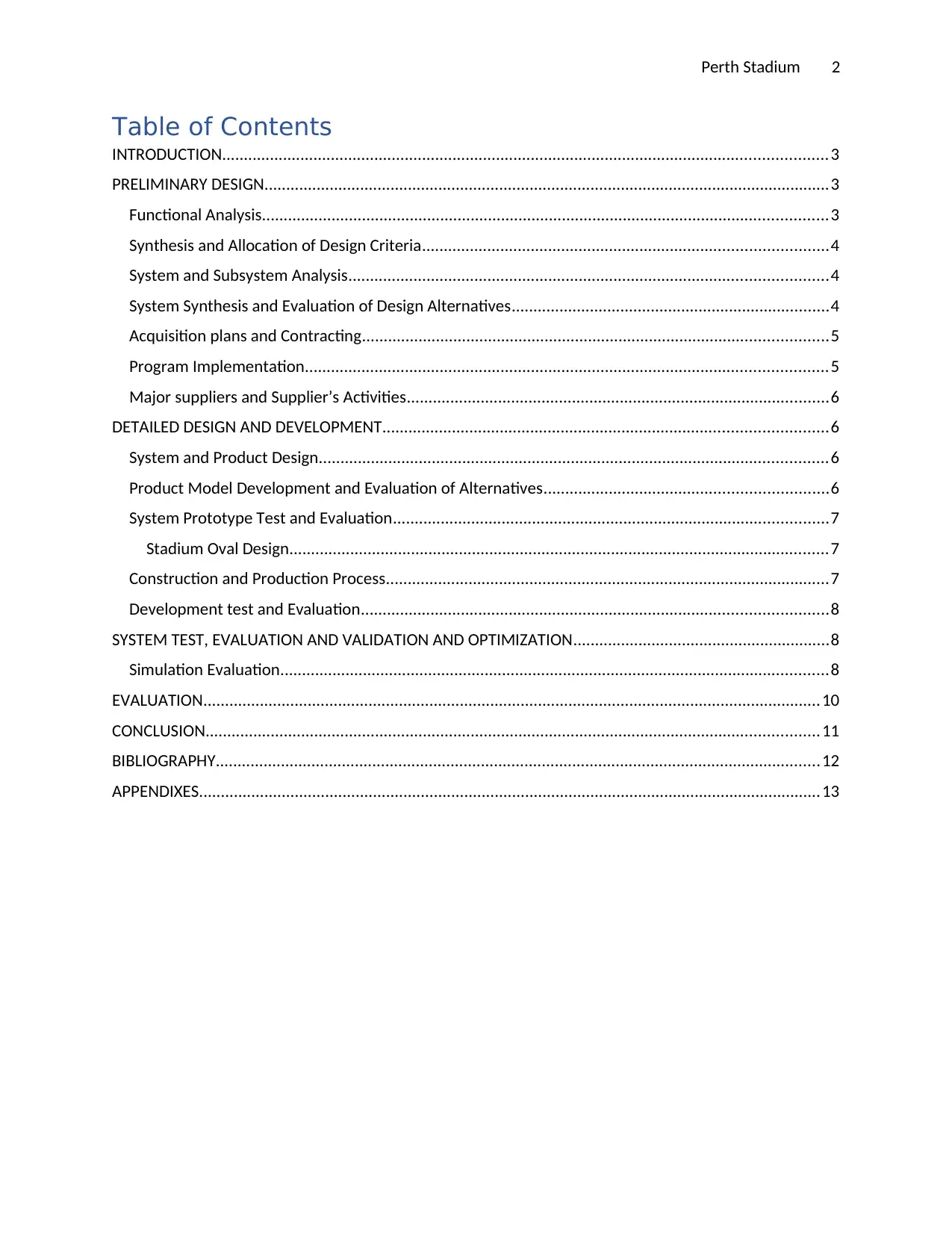
Perth Stadium 2
Table of Contents
INTRODUCTION...........................................................................................................................................3
PRELIMINARY DESIGN..................................................................................................................................3
Functional Analysis..................................................................................................................................3
Synthesis and Allocation of Design Criteria.............................................................................................4
System and Subsystem Analysis..............................................................................................................4
System Synthesis and Evaluation of Design Alternatives.........................................................................4
Acquisition plans and Contracting...........................................................................................................5
Program Implementation........................................................................................................................5
Major suppliers and Supplier’s Activities.................................................................................................6
DETAILED DESIGN AND DEVELOPMENT......................................................................................................6
System and Product Design.....................................................................................................................6
Product Model Development and Evaluation of Alternatives.................................................................6
System Prototype Test and Evaluation....................................................................................................7
Stadium Oval Design............................................................................................................................7
Construction and Production Process......................................................................................................7
Development test and Evaluation...........................................................................................................8
SYSTEM TEST, EVALUATION AND VALIDATION AND OPTIMIZATION...........................................................8
Simulation Evaluation..............................................................................................................................8
EVALUATION..............................................................................................................................................10
CONCLUSION.............................................................................................................................................11
BIBLIOGRAPHY...........................................................................................................................................12
APPENDIXES...............................................................................................................................................13
Table of Contents
INTRODUCTION...........................................................................................................................................3
PRELIMINARY DESIGN..................................................................................................................................3
Functional Analysis..................................................................................................................................3
Synthesis and Allocation of Design Criteria.............................................................................................4
System and Subsystem Analysis..............................................................................................................4
System Synthesis and Evaluation of Design Alternatives.........................................................................4
Acquisition plans and Contracting...........................................................................................................5
Program Implementation........................................................................................................................5
Major suppliers and Supplier’s Activities.................................................................................................6
DETAILED DESIGN AND DEVELOPMENT......................................................................................................6
System and Product Design.....................................................................................................................6
Product Model Development and Evaluation of Alternatives.................................................................6
System Prototype Test and Evaluation....................................................................................................7
Stadium Oval Design............................................................................................................................7
Construction and Production Process......................................................................................................7
Development test and Evaluation...........................................................................................................8
SYSTEM TEST, EVALUATION AND VALIDATION AND OPTIMIZATION...........................................................8
Simulation Evaluation..............................................................................................................................8
EVALUATION..............................................................................................................................................10
CONCLUSION.............................................................................................................................................11
BIBLIOGRAPHY...........................................................................................................................................12
APPENDIXES...............................................................................................................................................13
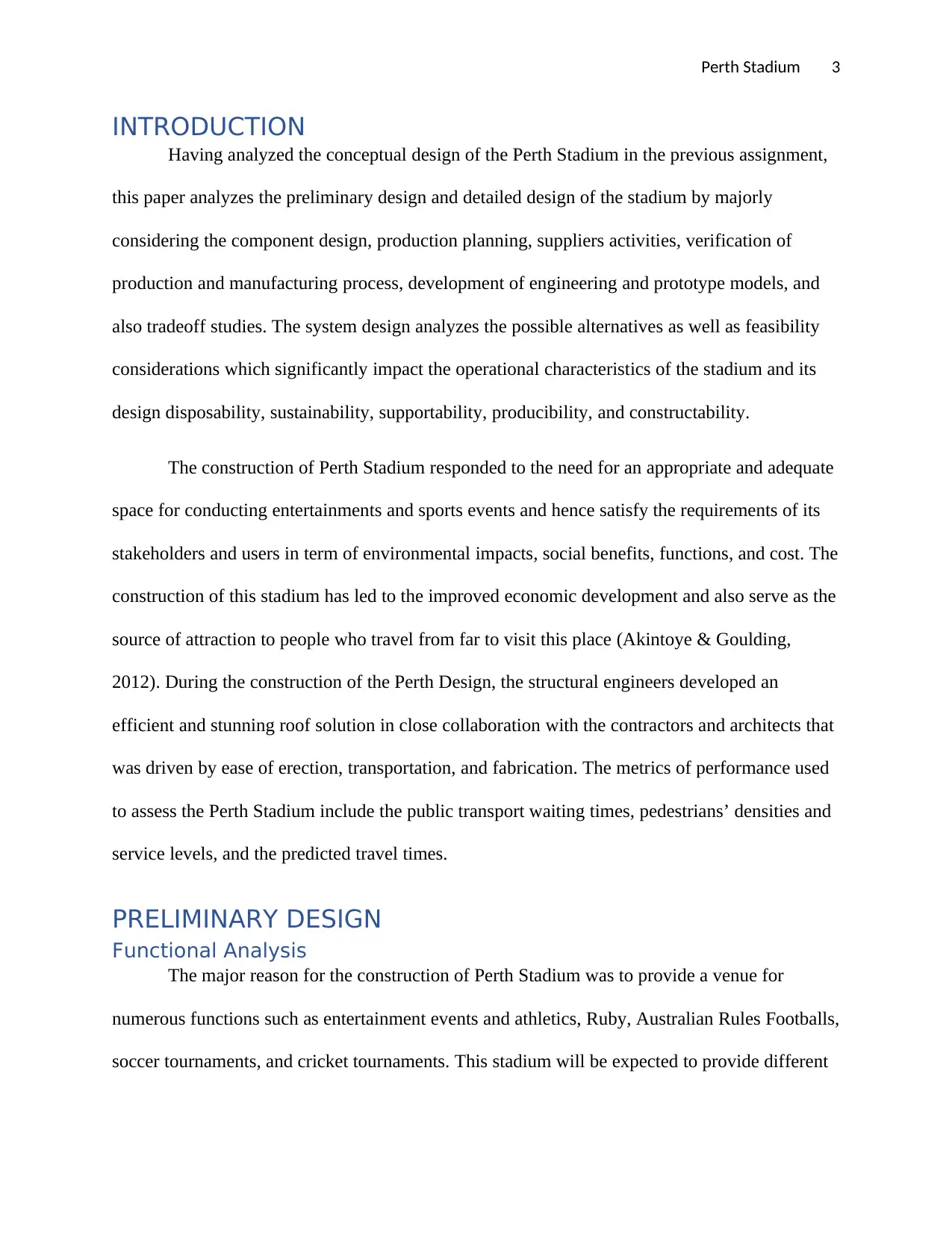
Perth Stadium 3
INTRODUCTION
Having analyzed the conceptual design of the Perth Stadium in the previous assignment,
this paper analyzes the preliminary design and detailed design of the stadium by majorly
considering the component design, production planning, suppliers activities, verification of
production and manufacturing process, development of engineering and prototype models, and
also tradeoff studies. The system design analyzes the possible alternatives as well as feasibility
considerations which significantly impact the operational characteristics of the stadium and its
design disposability, sustainability, supportability, producibility, and constructability.
The construction of Perth Stadium responded to the need for an appropriate and adequate
space for conducting entertainments and sports events and hence satisfy the requirements of its
stakeholders and users in term of environmental impacts, social benefits, functions, and cost. The
construction of this stadium has led to the improved economic development and also serve as the
source of attraction to people who travel from far to visit this place (Akintoye & Goulding,
2012). During the construction of the Perth Design, the structural engineers developed an
efficient and stunning roof solution in close collaboration with the contractors and architects that
was driven by ease of erection, transportation, and fabrication. The metrics of performance used
to assess the Perth Stadium include the public transport waiting times, pedestrians’ densities and
service levels, and the predicted travel times.
PRELIMINARY DESIGN
Functional Analysis
The major reason for the construction of Perth Stadium was to provide a venue for
numerous functions such as entertainment events and athletics, Ruby, Australian Rules Footballs,
soccer tournaments, and cricket tournaments. This stadium will be expected to provide different
INTRODUCTION
Having analyzed the conceptual design of the Perth Stadium in the previous assignment,
this paper analyzes the preliminary design and detailed design of the stadium by majorly
considering the component design, production planning, suppliers activities, verification of
production and manufacturing process, development of engineering and prototype models, and
also tradeoff studies. The system design analyzes the possible alternatives as well as feasibility
considerations which significantly impact the operational characteristics of the stadium and its
design disposability, sustainability, supportability, producibility, and constructability.
The construction of Perth Stadium responded to the need for an appropriate and adequate
space for conducting entertainments and sports events and hence satisfy the requirements of its
stakeholders and users in term of environmental impacts, social benefits, functions, and cost. The
construction of this stadium has led to the improved economic development and also serve as the
source of attraction to people who travel from far to visit this place (Akintoye & Goulding,
2012). During the construction of the Perth Design, the structural engineers developed an
efficient and stunning roof solution in close collaboration with the contractors and architects that
was driven by ease of erection, transportation, and fabrication. The metrics of performance used
to assess the Perth Stadium include the public transport waiting times, pedestrians’ densities and
service levels, and the predicted travel times.
PRELIMINARY DESIGN
Functional Analysis
The major reason for the construction of Perth Stadium was to provide a venue for
numerous functions such as entertainment events and athletics, Ruby, Australian Rules Footballs,
soccer tournaments, and cricket tournaments. This stadium will be expected to provide different
⊘ This is a preview!⊘
Do you want full access?
Subscribe today to unlock all pages.

Trusted by 1+ million students worldwide
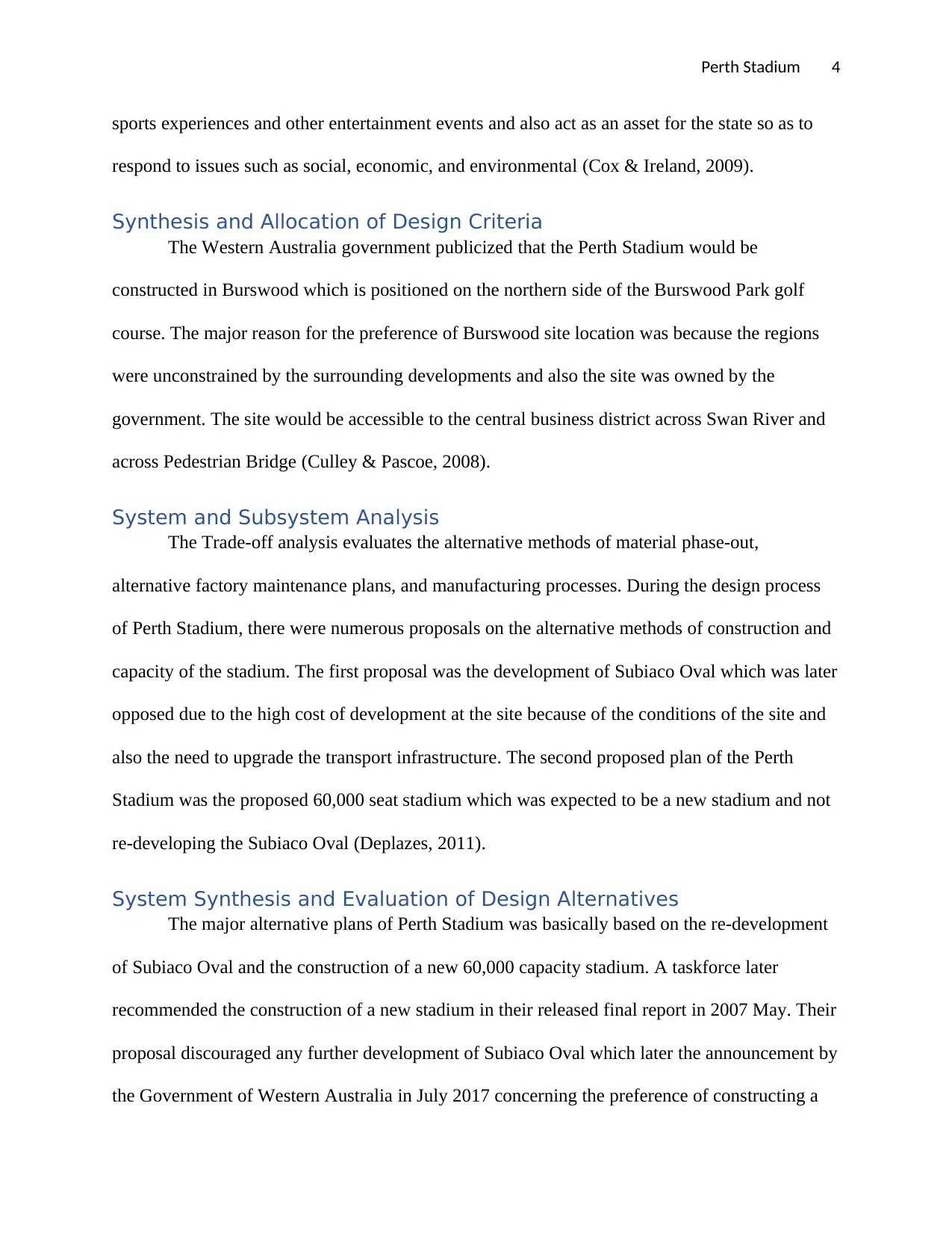
Perth Stadium 4
sports experiences and other entertainment events and also act as an asset for the state so as to
respond to issues such as social, economic, and environmental (Cox & Ireland, 2009).
Synthesis and Allocation of Design Criteria
The Western Australia government publicized that the Perth Stadium would be
constructed in Burswood which is positioned on the northern side of the Burswood Park golf
course. The major reason for the preference of Burswood site location was because the regions
were unconstrained by the surrounding developments and also the site was owned by the
government. The site would be accessible to the central business district across Swan River and
across Pedestrian Bridge (Culley & Pascoe, 2008).
System and Subsystem Analysis
The Trade-off analysis evaluates the alternative methods of material phase-out,
alternative factory maintenance plans, and manufacturing processes. During the design process
of Perth Stadium, there were numerous proposals on the alternative methods of construction and
capacity of the stadium. The first proposal was the development of Subiaco Oval which was later
opposed due to the high cost of development at the site because of the conditions of the site and
also the need to upgrade the transport infrastructure. The second proposed plan of the Perth
Stadium was the proposed 60,000 seat stadium which was expected to be a new stadium and not
re-developing the Subiaco Oval (Deplazes, 2011).
System Synthesis and Evaluation of Design Alternatives
The major alternative plans of Perth Stadium was basically based on the re-development
of Subiaco Oval and the construction of a new 60,000 capacity stadium. A taskforce later
recommended the construction of a new stadium in their released final report in 2007 May. Their
proposal discouraged any further development of Subiaco Oval which later the announcement by
the Government of Western Australia in July 2017 concerning the preference of constructing a
sports experiences and other entertainment events and also act as an asset for the state so as to
respond to issues such as social, economic, and environmental (Cox & Ireland, 2009).
Synthesis and Allocation of Design Criteria
The Western Australia government publicized that the Perth Stadium would be
constructed in Burswood which is positioned on the northern side of the Burswood Park golf
course. The major reason for the preference of Burswood site location was because the regions
were unconstrained by the surrounding developments and also the site was owned by the
government. The site would be accessible to the central business district across Swan River and
across Pedestrian Bridge (Culley & Pascoe, 2008).
System and Subsystem Analysis
The Trade-off analysis evaluates the alternative methods of material phase-out,
alternative factory maintenance plans, and manufacturing processes. During the design process
of Perth Stadium, there were numerous proposals on the alternative methods of construction and
capacity of the stadium. The first proposal was the development of Subiaco Oval which was later
opposed due to the high cost of development at the site because of the conditions of the site and
also the need to upgrade the transport infrastructure. The second proposed plan of the Perth
Stadium was the proposed 60,000 seat stadium which was expected to be a new stadium and not
re-developing the Subiaco Oval (Deplazes, 2011).
System Synthesis and Evaluation of Design Alternatives
The major alternative plans of Perth Stadium was basically based on the re-development
of Subiaco Oval and the construction of a new 60,000 capacity stadium. A taskforce later
recommended the construction of a new stadium in their released final report in 2007 May. Their
proposal discouraged any further development of Subiaco Oval which later the announcement by
the Government of Western Australia in July 2017 concerning the preference of constructing a
Paraphrase This Document
Need a fresh take? Get an instant paraphrase of this document with our AI Paraphraser
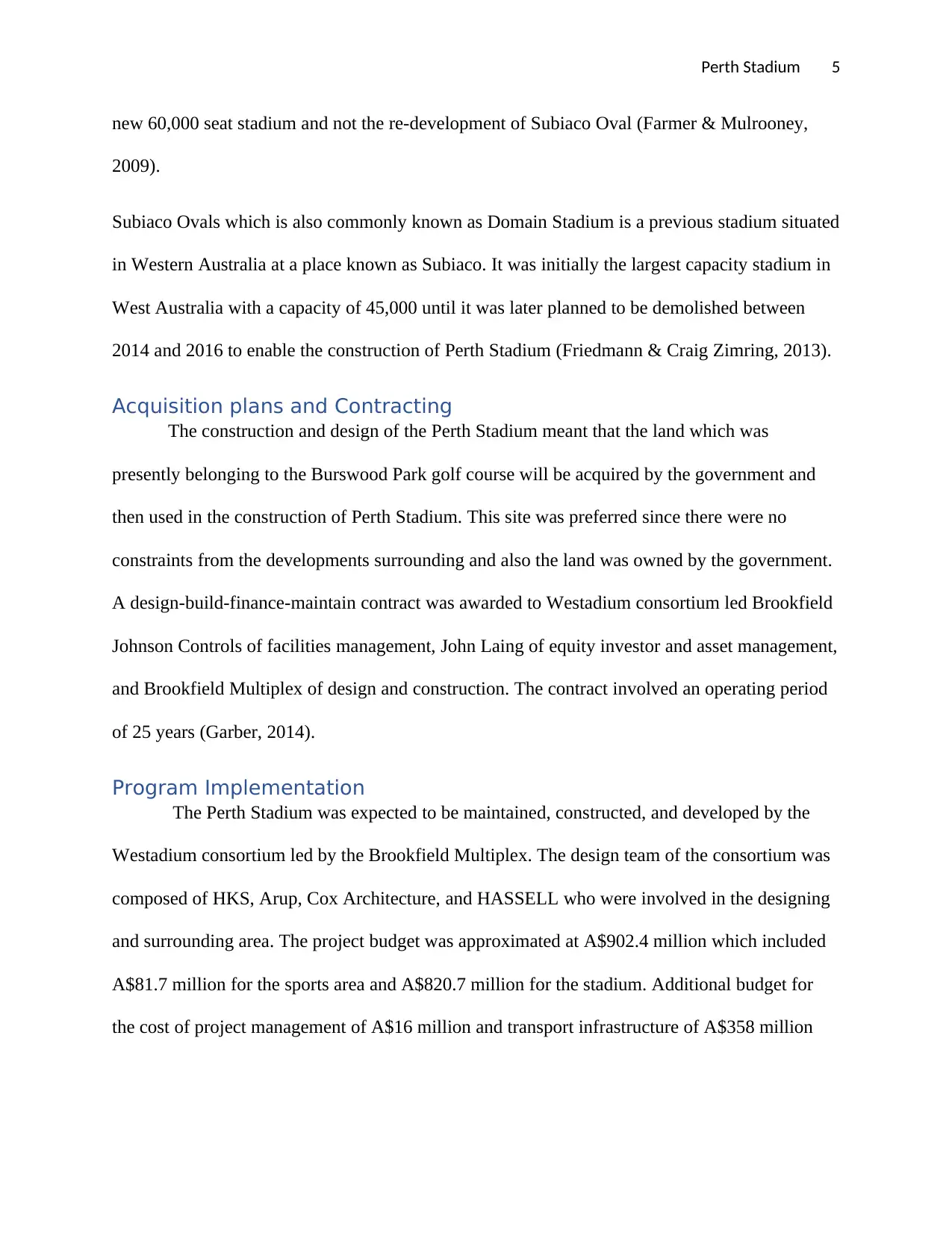
Perth Stadium 5
new 60,000 seat stadium and not the re-development of Subiaco Oval (Farmer & Mulrooney,
2009).
Subiaco Ovals which is also commonly known as Domain Stadium is a previous stadium situated
in Western Australia at a place known as Subiaco. It was initially the largest capacity stadium in
West Australia with a capacity of 45,000 until it was later planned to be demolished between
2014 and 2016 to enable the construction of Perth Stadium (Friedmann & Craig Zimring, 2013).
Acquisition plans and Contracting
The construction and design of the Perth Stadium meant that the land which was
presently belonging to the Burswood Park golf course will be acquired by the government and
then used in the construction of Perth Stadium. This site was preferred since there were no
constraints from the developments surrounding and also the land was owned by the government.
A design-build-finance-maintain contract was awarded to Westadium consortium led Brookfield
Johnson Controls of facilities management, John Laing of equity investor and asset management,
and Brookfield Multiplex of design and construction. The contract involved an operating period
of 25 years (Garber, 2014).
Program Implementation
The Perth Stadium was expected to be maintained, constructed, and developed by the
Westadium consortium led by the Brookfield Multiplex. The design team of the consortium was
composed of HKS, Arup, Cox Architecture, and HASSELL who were involved in the designing
and surrounding area. The project budget was approximated at A$902.4 million which included
A$81.7 million for the sports area and A$820.7 million for the stadium. Additional budget for
the cost of project management of A$16 million and transport infrastructure of A$358 million
new 60,000 seat stadium and not the re-development of Subiaco Oval (Farmer & Mulrooney,
2009).
Subiaco Ovals which is also commonly known as Domain Stadium is a previous stadium situated
in Western Australia at a place known as Subiaco. It was initially the largest capacity stadium in
West Australia with a capacity of 45,000 until it was later planned to be demolished between
2014 and 2016 to enable the construction of Perth Stadium (Friedmann & Craig Zimring, 2013).
Acquisition plans and Contracting
The construction and design of the Perth Stadium meant that the land which was
presently belonging to the Burswood Park golf course will be acquired by the government and
then used in the construction of Perth Stadium. This site was preferred since there were no
constraints from the developments surrounding and also the land was owned by the government.
A design-build-finance-maintain contract was awarded to Westadium consortium led Brookfield
Johnson Controls of facilities management, John Laing of equity investor and asset management,
and Brookfield Multiplex of design and construction. The contract involved an operating period
of 25 years (Garber, 2014).
Program Implementation
The Perth Stadium was expected to be maintained, constructed, and developed by the
Westadium consortium led by the Brookfield Multiplex. The design team of the consortium was
composed of HKS, Arup, Cox Architecture, and HASSELL who were involved in the designing
and surrounding area. The project budget was approximated at A$902.4 million which included
A$81.7 million for the sports area and A$820.7 million for the stadium. Additional budget for
the cost of project management of A$16 million and transport infrastructure of A$358 million
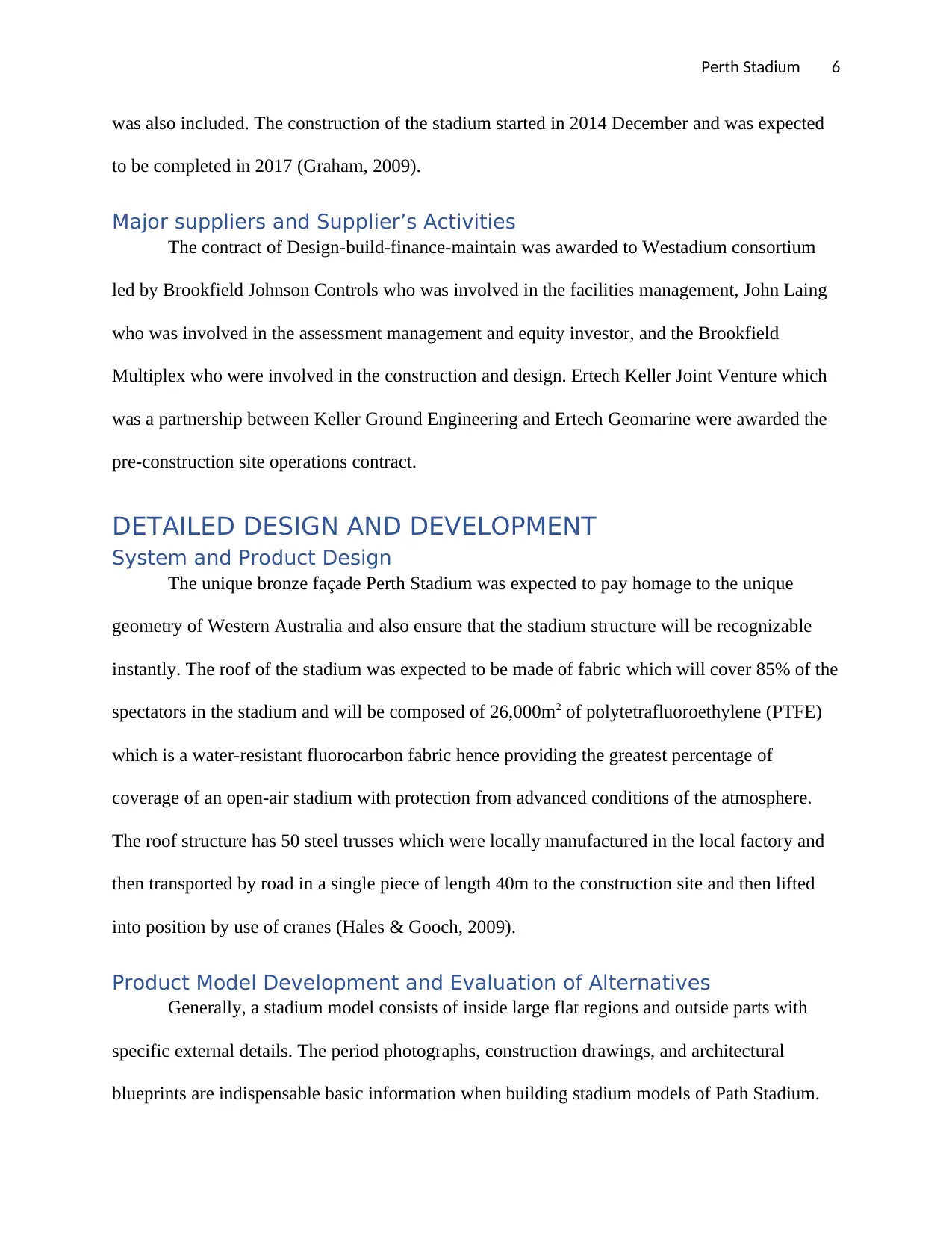
Perth Stadium 6
was also included. The construction of the stadium started in 2014 December and was expected
to be completed in 2017 (Graham, 2009).
Major suppliers and Supplier’s Activities
The contract of Design-build-finance-maintain was awarded to Westadium consortium
led by Brookfield Johnson Controls who was involved in the facilities management, John Laing
who was involved in the assessment management and equity investor, and the Brookfield
Multiplex who were involved in the construction and design. Ertech Keller Joint Venture which
was a partnership between Keller Ground Engineering and Ertech Geomarine were awarded the
pre-construction site operations contract.
DETAILED DESIGN AND DEVELOPMENT
System and Product Design
The unique bronze façade Perth Stadium was expected to pay homage to the unique
geometry of Western Australia and also ensure that the stadium structure will be recognizable
instantly. The roof of the stadium was expected to be made of fabric which will cover 85% of the
spectators in the stadium and will be composed of 26,000m2 of polytetrafluoroethylene (PTFE)
which is a water-resistant fluorocarbon fabric hence providing the greatest percentage of
coverage of an open-air stadium with protection from advanced conditions of the atmosphere.
The roof structure has 50 steel trusses which were locally manufactured in the local factory and
then transported by road in a single piece of length 40m to the construction site and then lifted
into position by use of cranes (Hales & Gooch, 2009).
Product Model Development and Evaluation of Alternatives
Generally, a stadium model consists of inside large flat regions and outside parts with
specific external details. The period photographs, construction drawings, and architectural
blueprints are indispensable basic information when building stadium models of Path Stadium.
was also included. The construction of the stadium started in 2014 December and was expected
to be completed in 2017 (Graham, 2009).
Major suppliers and Supplier’s Activities
The contract of Design-build-finance-maintain was awarded to Westadium consortium
led by Brookfield Johnson Controls who was involved in the facilities management, John Laing
who was involved in the assessment management and equity investor, and the Brookfield
Multiplex who were involved in the construction and design. Ertech Keller Joint Venture which
was a partnership between Keller Ground Engineering and Ertech Geomarine were awarded the
pre-construction site operations contract.
DETAILED DESIGN AND DEVELOPMENT
System and Product Design
The unique bronze façade Perth Stadium was expected to pay homage to the unique
geometry of Western Australia and also ensure that the stadium structure will be recognizable
instantly. The roof of the stadium was expected to be made of fabric which will cover 85% of the
spectators in the stadium and will be composed of 26,000m2 of polytetrafluoroethylene (PTFE)
which is a water-resistant fluorocarbon fabric hence providing the greatest percentage of
coverage of an open-air stadium with protection from advanced conditions of the atmosphere.
The roof structure has 50 steel trusses which were locally manufactured in the local factory and
then transported by road in a single piece of length 40m to the construction site and then lifted
into position by use of cranes (Hales & Gooch, 2009).
Product Model Development and Evaluation of Alternatives
Generally, a stadium model consists of inside large flat regions and outside parts with
specific external details. The period photographs, construction drawings, and architectural
blueprints are indispensable basic information when building stadium models of Path Stadium.
⊘ This is a preview!⊘
Do you want full access?
Subscribe today to unlock all pages.

Trusted by 1+ million students worldwide
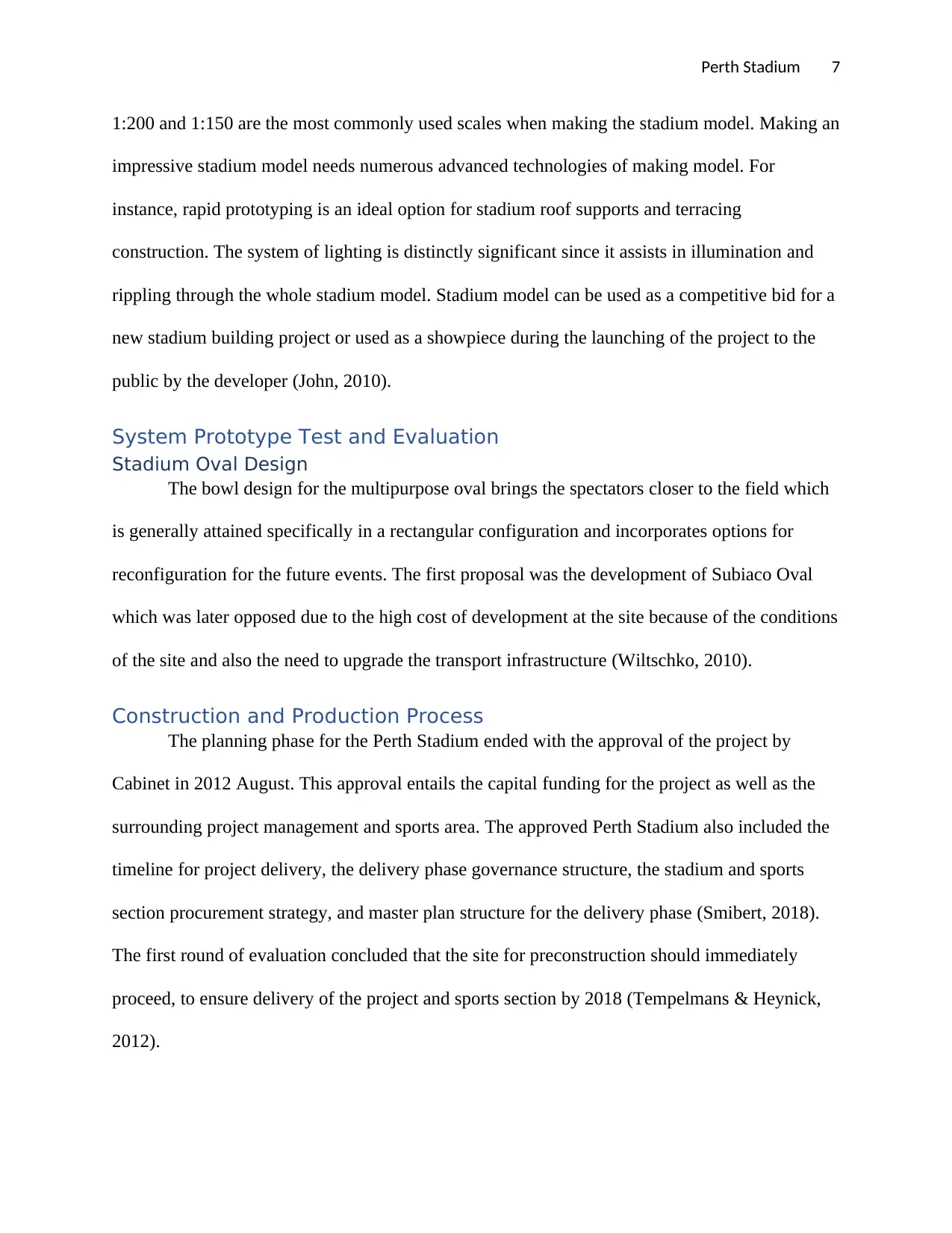
Perth Stadium 7
1:200 and 1:150 are the most commonly used scales when making the stadium model. Making an
impressive stadium model needs numerous advanced technologies of making model. For
instance, rapid prototyping is an ideal option for stadium roof supports and terracing
construction. The system of lighting is distinctly significant since it assists in illumination and
rippling through the whole stadium model. Stadium model can be used as a competitive bid for a
new stadium building project or used as a showpiece during the launching of the project to the
public by the developer (John, 2010).
System Prototype Test and Evaluation
Stadium Oval Design
The bowl design for the multipurpose oval brings the spectators closer to the field which
is generally attained specifically in a rectangular configuration and incorporates options for
reconfiguration for the future events. The first proposal was the development of Subiaco Oval
which was later opposed due to the high cost of development at the site because of the conditions
of the site and also the need to upgrade the transport infrastructure (Wiltschko, 2010).
Construction and Production Process
The planning phase for the Perth Stadium ended with the approval of the project by
Cabinet in 2012 August. This approval entails the capital funding for the project as well as the
surrounding project management and sports area. The approved Perth Stadium also included the
timeline for project delivery, the delivery phase governance structure, the stadium and sports
section procurement strategy, and master plan structure for the delivery phase (Smibert, 2018).
The first round of evaluation concluded that the site for preconstruction should immediately
proceed, to ensure delivery of the project and sports section by 2018 (Tempelmans & Heynick,
2012).
1:200 and 1:150 are the most commonly used scales when making the stadium model. Making an
impressive stadium model needs numerous advanced technologies of making model. For
instance, rapid prototyping is an ideal option for stadium roof supports and terracing
construction. The system of lighting is distinctly significant since it assists in illumination and
rippling through the whole stadium model. Stadium model can be used as a competitive bid for a
new stadium building project or used as a showpiece during the launching of the project to the
public by the developer (John, 2010).
System Prototype Test and Evaluation
Stadium Oval Design
The bowl design for the multipurpose oval brings the spectators closer to the field which
is generally attained specifically in a rectangular configuration and incorporates options for
reconfiguration for the future events. The first proposal was the development of Subiaco Oval
which was later opposed due to the high cost of development at the site because of the conditions
of the site and also the need to upgrade the transport infrastructure (Wiltschko, 2010).
Construction and Production Process
The planning phase for the Perth Stadium ended with the approval of the project by
Cabinet in 2012 August. This approval entails the capital funding for the project as well as the
surrounding project management and sports area. The approved Perth Stadium also included the
timeline for project delivery, the delivery phase governance structure, the stadium and sports
section procurement strategy, and master plan structure for the delivery phase (Smibert, 2018).
The first round of evaluation concluded that the site for preconstruction should immediately
proceed, to ensure delivery of the project and sports section by 2018 (Tempelmans & Heynick,
2012).
Paraphrase This Document
Need a fresh take? Get an instant paraphrase of this document with our AI Paraphraser
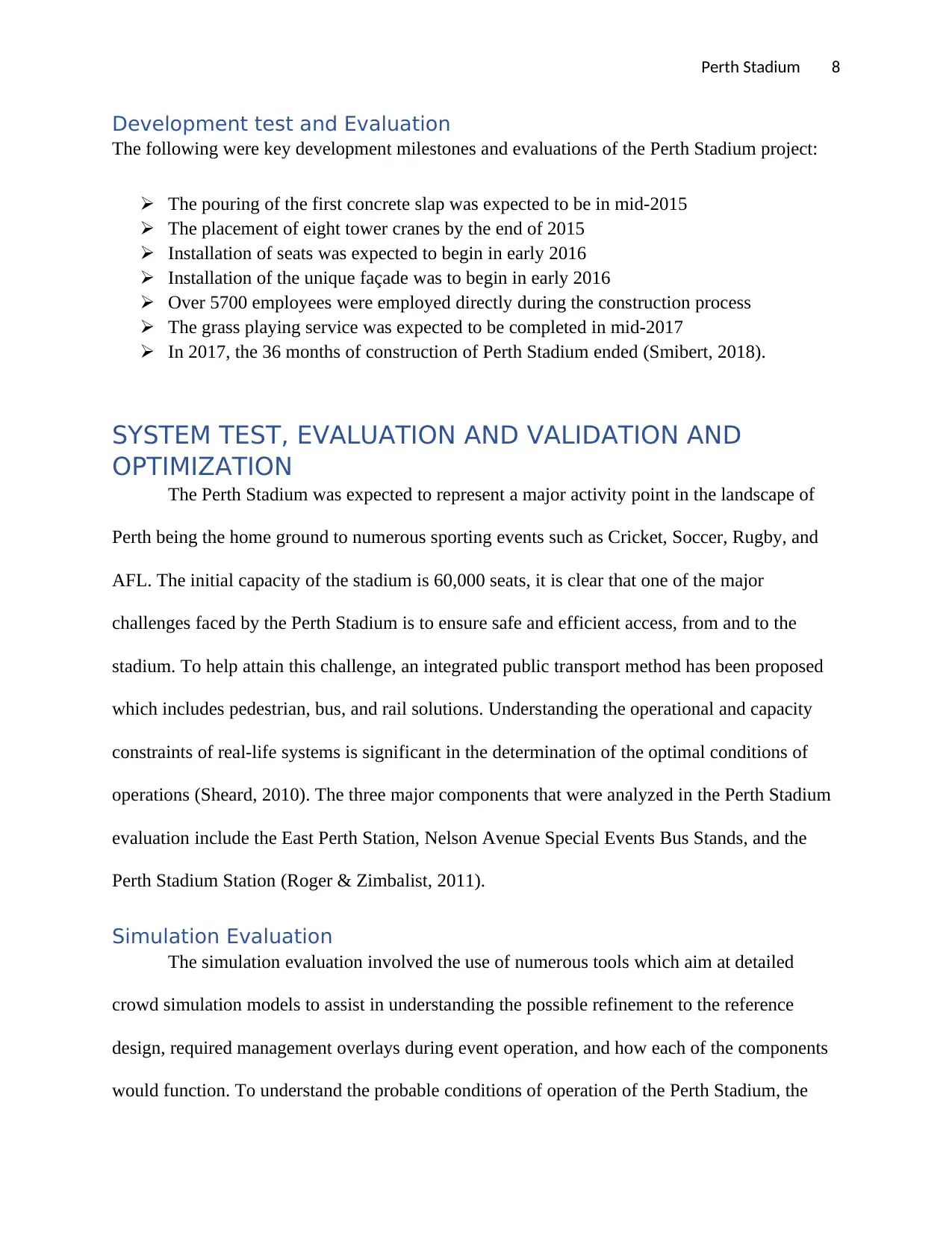
Perth Stadium 8
Development test and Evaluation
The following were key development milestones and evaluations of the Perth Stadium project:
The pouring of the first concrete slap was expected to be in mid-2015
The placement of eight tower cranes by the end of 2015
Installation of seats was expected to begin in early 2016
Installation of the unique façade was to begin in early 2016
Over 5700 employees were employed directly during the construction process
The grass playing service was expected to be completed in mid-2017
In 2017, the 36 months of construction of Perth Stadium ended (Smibert, 2018).
SYSTEM TEST, EVALUATION AND VALIDATION AND
OPTIMIZATION
The Perth Stadium was expected to represent a major activity point in the landscape of
Perth being the home ground to numerous sporting events such as Cricket, Soccer, Rugby, and
AFL. The initial capacity of the stadium is 60,000 seats, it is clear that one of the major
challenges faced by the Perth Stadium is to ensure safe and efficient access, from and to the
stadium. To help attain this challenge, an integrated public transport method has been proposed
which includes pedestrian, bus, and rail solutions. Understanding the operational and capacity
constraints of real-life systems is significant in the determination of the optimal conditions of
operations (Sheard, 2010). The three major components that were analyzed in the Perth Stadium
evaluation include the East Perth Station, Nelson Avenue Special Events Bus Stands, and the
Perth Stadium Station (Roger & Zimbalist, 2011).
Simulation Evaluation
The simulation evaluation involved the use of numerous tools which aim at detailed
crowd simulation models to assist in understanding the possible refinement to the reference
design, required management overlays during event operation, and how each of the components
would function. To understand the probable conditions of operation of the Perth Stadium, the
Development test and Evaluation
The following were key development milestones and evaluations of the Perth Stadium project:
The pouring of the first concrete slap was expected to be in mid-2015
The placement of eight tower cranes by the end of 2015
Installation of seats was expected to begin in early 2016
Installation of the unique façade was to begin in early 2016
Over 5700 employees were employed directly during the construction process
The grass playing service was expected to be completed in mid-2017
In 2017, the 36 months of construction of Perth Stadium ended (Smibert, 2018).
SYSTEM TEST, EVALUATION AND VALIDATION AND
OPTIMIZATION
The Perth Stadium was expected to represent a major activity point in the landscape of
Perth being the home ground to numerous sporting events such as Cricket, Soccer, Rugby, and
AFL. The initial capacity of the stadium is 60,000 seats, it is clear that one of the major
challenges faced by the Perth Stadium is to ensure safe and efficient access, from and to the
stadium. To help attain this challenge, an integrated public transport method has been proposed
which includes pedestrian, bus, and rail solutions. Understanding the operational and capacity
constraints of real-life systems is significant in the determination of the optimal conditions of
operations (Sheard, 2010). The three major components that were analyzed in the Perth Stadium
evaluation include the East Perth Station, Nelson Avenue Special Events Bus Stands, and the
Perth Stadium Station (Roger & Zimbalist, 2011).
Simulation Evaluation
The simulation evaluation involved the use of numerous tools which aim at detailed
crowd simulation models to assist in understanding the possible refinement to the reference
design, required management overlays during event operation, and how each of the components
would function. To understand the probable conditions of operation of the Perth Stadium, the
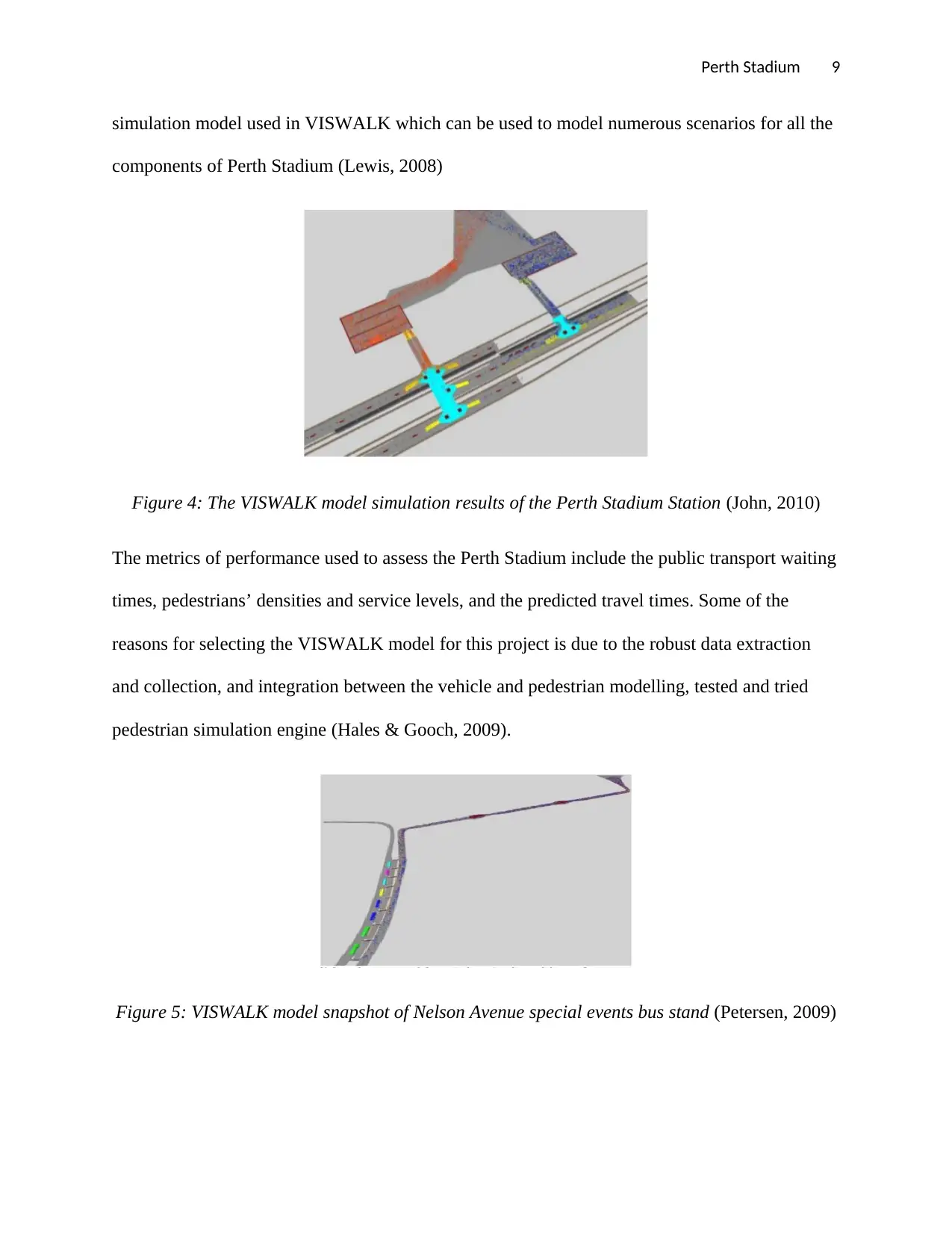
Perth Stadium 9
simulation model used in VISWALK which can be used to model numerous scenarios for all the
components of Perth Stadium (Lewis, 2008)
Figure 4: The VISWALK model simulation results of the Perth Stadium Station (John, 2010)
The metrics of performance used to assess the Perth Stadium include the public transport waiting
times, pedestrians’ densities and service levels, and the predicted travel times. Some of the
reasons for selecting the VISWALK model for this project is due to the robust data extraction
and collection, and integration between the vehicle and pedestrian modelling, tested and tried
pedestrian simulation engine (Hales & Gooch, 2009).
Figure 5: VISWALK model snapshot of Nelson Avenue special events bus stand (Petersen, 2009)
simulation model used in VISWALK which can be used to model numerous scenarios for all the
components of Perth Stadium (Lewis, 2008)
Figure 4: The VISWALK model simulation results of the Perth Stadium Station (John, 2010)
The metrics of performance used to assess the Perth Stadium include the public transport waiting
times, pedestrians’ densities and service levels, and the predicted travel times. Some of the
reasons for selecting the VISWALK model for this project is due to the robust data extraction
and collection, and integration between the vehicle and pedestrian modelling, tested and tried
pedestrian simulation engine (Hales & Gooch, 2009).
Figure 5: VISWALK model snapshot of Nelson Avenue special events bus stand (Petersen, 2009)
⊘ This is a preview!⊘
Do you want full access?
Subscribe today to unlock all pages.

Trusted by 1+ million students worldwide
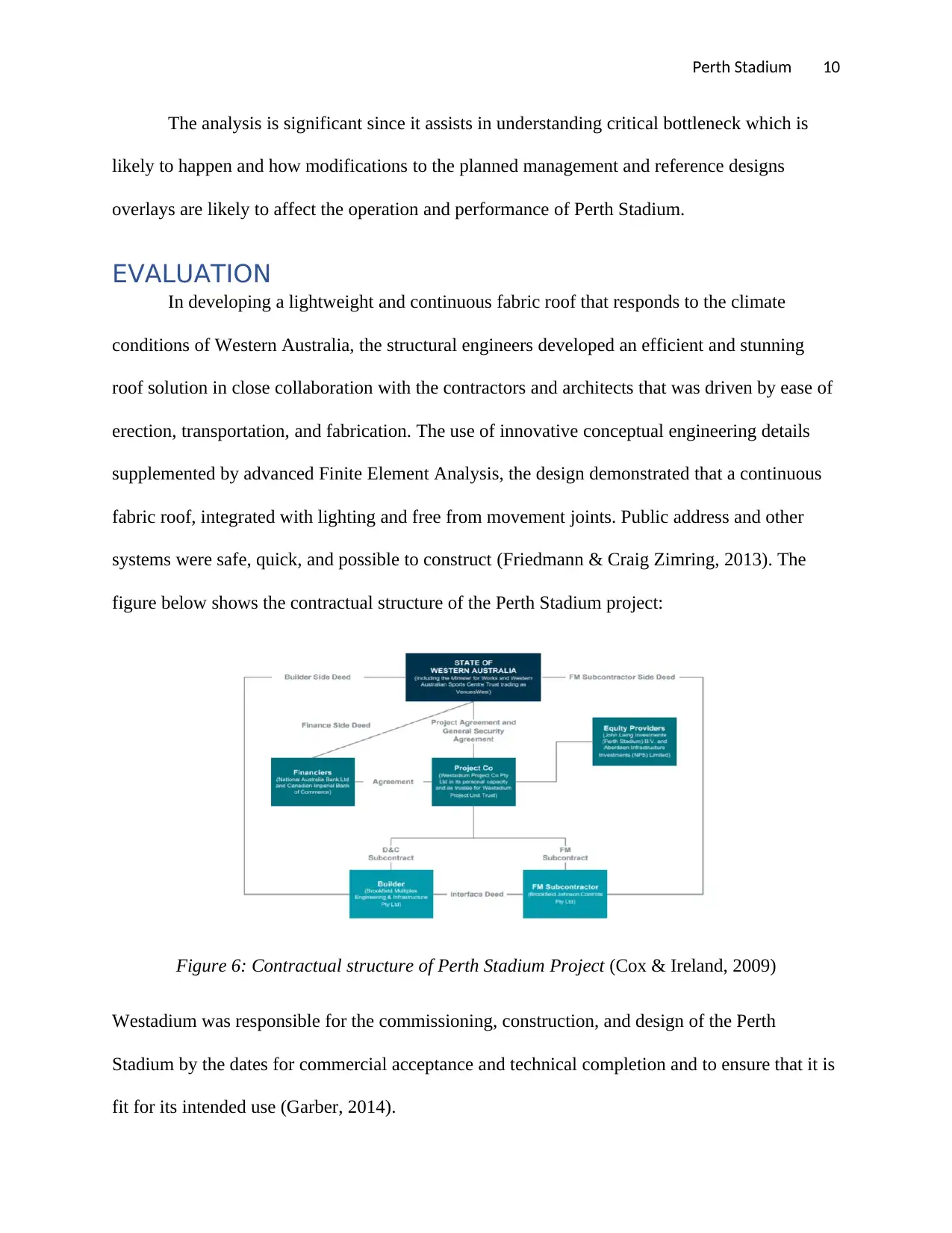
Perth Stadium 10
The analysis is significant since it assists in understanding critical bottleneck which is
likely to happen and how modifications to the planned management and reference designs
overlays are likely to affect the operation and performance of Perth Stadium.
EVALUATION
In developing a lightweight and continuous fabric roof that responds to the climate
conditions of Western Australia, the structural engineers developed an efficient and stunning
roof solution in close collaboration with the contractors and architects that was driven by ease of
erection, transportation, and fabrication. The use of innovative conceptual engineering details
supplemented by advanced Finite Element Analysis, the design demonstrated that a continuous
fabric roof, integrated with lighting and free from movement joints. Public address and other
systems were safe, quick, and possible to construct (Friedmann & Craig Zimring, 2013). The
figure below shows the contractual structure of the Perth Stadium project:
Figure 6: Contractual structure of Perth Stadium Project (Cox & Ireland, 2009)
Westadium was responsible for the commissioning, construction, and design of the Perth
Stadium by the dates for commercial acceptance and technical completion and to ensure that it is
fit for its intended use (Garber, 2014).
The analysis is significant since it assists in understanding critical bottleneck which is
likely to happen and how modifications to the planned management and reference designs
overlays are likely to affect the operation and performance of Perth Stadium.
EVALUATION
In developing a lightweight and continuous fabric roof that responds to the climate
conditions of Western Australia, the structural engineers developed an efficient and stunning
roof solution in close collaboration with the contractors and architects that was driven by ease of
erection, transportation, and fabrication. The use of innovative conceptual engineering details
supplemented by advanced Finite Element Analysis, the design demonstrated that a continuous
fabric roof, integrated with lighting and free from movement joints. Public address and other
systems were safe, quick, and possible to construct (Friedmann & Craig Zimring, 2013). The
figure below shows the contractual structure of the Perth Stadium project:
Figure 6: Contractual structure of Perth Stadium Project (Cox & Ireland, 2009)
Westadium was responsible for the commissioning, construction, and design of the Perth
Stadium by the dates for commercial acceptance and technical completion and to ensure that it is
fit for its intended use (Garber, 2014).
Paraphrase This Document
Need a fresh take? Get an instant paraphrase of this document with our AI Paraphraser
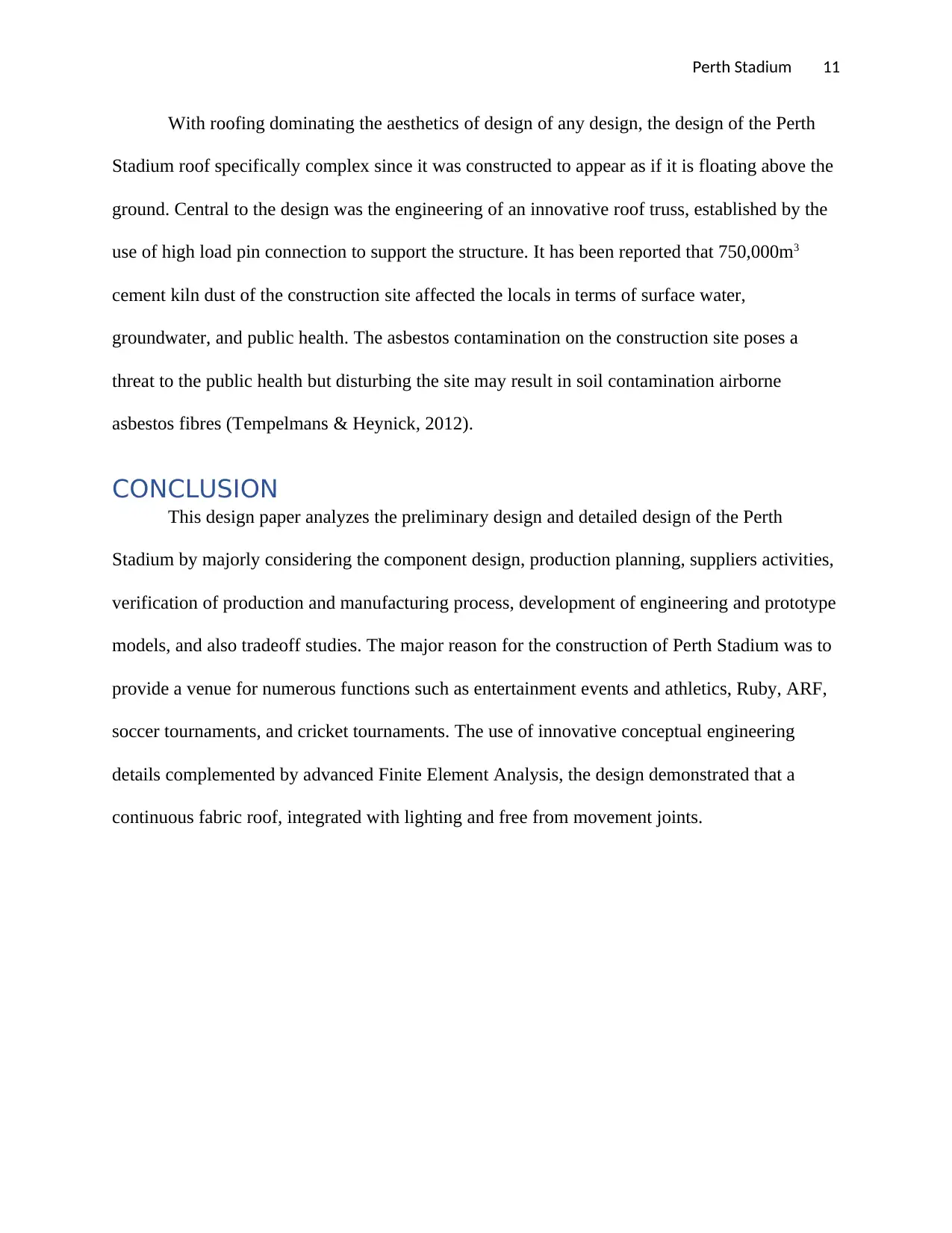
Perth Stadium 11
With roofing dominating the aesthetics of design of any design, the design of the Perth
Stadium roof specifically complex since it was constructed to appear as if it is floating above the
ground. Central to the design was the engineering of an innovative roof truss, established by the
use of high load pin connection to support the structure. It has been reported that 750,000m3
cement kiln dust of the construction site affected the locals in terms of surface water,
groundwater, and public health. The asbestos contamination on the construction site poses a
threat to the public health but disturbing the site may result in soil contamination airborne
asbestos fibres (Tempelmans & Heynick, 2012).
CONCLUSION
This design paper analyzes the preliminary design and detailed design of the Perth
Stadium by majorly considering the component design, production planning, suppliers activities,
verification of production and manufacturing process, development of engineering and prototype
models, and also tradeoff studies. The major reason for the construction of Perth Stadium was to
provide a venue for numerous functions such as entertainment events and athletics, Ruby, ARF,
soccer tournaments, and cricket tournaments. The use of innovative conceptual engineering
details complemented by advanced Finite Element Analysis, the design demonstrated that a
continuous fabric roof, integrated with lighting and free from movement joints.
With roofing dominating the aesthetics of design of any design, the design of the Perth
Stadium roof specifically complex since it was constructed to appear as if it is floating above the
ground. Central to the design was the engineering of an innovative roof truss, established by the
use of high load pin connection to support the structure. It has been reported that 750,000m3
cement kiln dust of the construction site affected the locals in terms of surface water,
groundwater, and public health. The asbestos contamination on the construction site poses a
threat to the public health but disturbing the site may result in soil contamination airborne
asbestos fibres (Tempelmans & Heynick, 2012).
CONCLUSION
This design paper analyzes the preliminary design and detailed design of the Perth
Stadium by majorly considering the component design, production planning, suppliers activities,
verification of production and manufacturing process, development of engineering and prototype
models, and also tradeoff studies. The major reason for the construction of Perth Stadium was to
provide a venue for numerous functions such as entertainment events and athletics, Ruby, ARF,
soccer tournaments, and cricket tournaments. The use of innovative conceptual engineering
details complemented by advanced Finite Element Analysis, the design demonstrated that a
continuous fabric roof, integrated with lighting and free from movement joints.
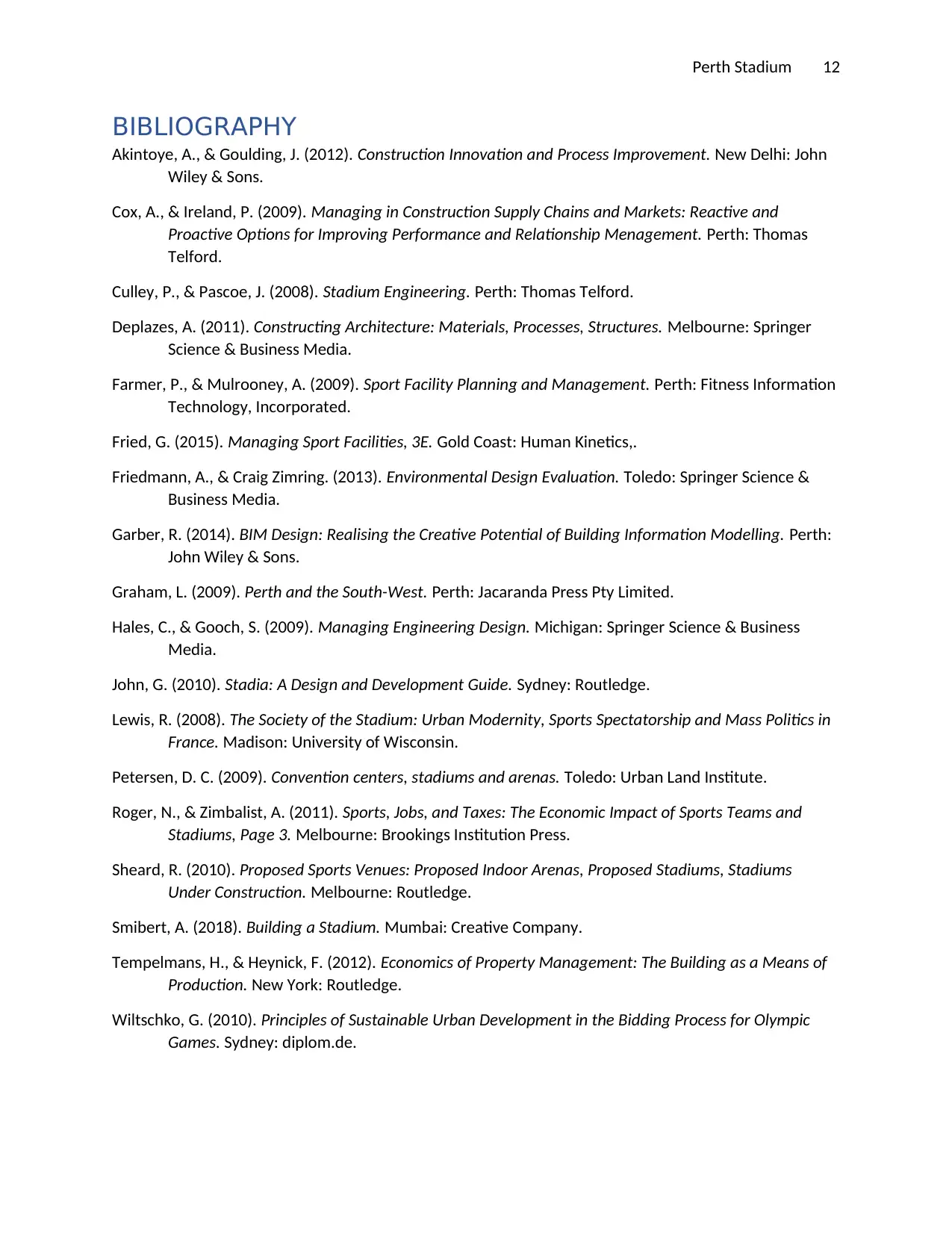
Perth Stadium 12
BIBLIOGRAPHY
Akintoye, A., & Goulding, J. (2012). Construction Innovation and Process Improvement. New Delhi: John
Wiley & Sons.
Cox, A., & Ireland, P. (2009). Managing in Construction Supply Chains and Markets: Reactive and
Proactive Options for Improving Performance and Relationship Menagement. Perth: Thomas
Telford.
Culley, P., & Pascoe, J. (2008). Stadium Engineering. Perth: Thomas Telford.
Deplazes, A. (2011). Constructing Architecture: Materials, Processes, Structures. Melbourne: Springer
Science & Business Media.
Farmer, P., & Mulrooney, A. (2009). Sport Facility Planning and Management. Perth: Fitness Information
Technology, Incorporated.
Fried, G. (2015). Managing Sport Facilities, 3E. Gold Coast: Human Kinetics,.
Friedmann, A., & Craig Zimring. (2013). Environmental Design Evaluation. Toledo: Springer Science &
Business Media.
Garber, R. (2014). BIM Design: Realising the Creative Potential of Building Information Modelling. Perth:
John Wiley & Sons.
Graham, L. (2009). Perth and the South-West. Perth: Jacaranda Press Pty Limited.
Hales, C., & Gooch, S. (2009). Managing Engineering Design. Michigan: Springer Science & Business
Media.
John, G. (2010). Stadia: A Design and Development Guide. Sydney: Routledge.
Lewis, R. (2008). The Society of the Stadium: Urban Modernity, Sports Spectatorship and Mass Politics in
France. Madison: University of Wisconsin.
Petersen, D. C. (2009). Convention centers, stadiums and arenas. Toledo: Urban Land Institute.
Roger, N., & Zimbalist, A. (2011). Sports, Jobs, and Taxes: The Economic Impact of Sports Teams and
Stadiums, Page 3. Melbourne: Brookings Institution Press.
Sheard, R. (2010). Proposed Sports Venues: Proposed Indoor Arenas, Proposed Stadiums, Stadiums
Under Construction. Melbourne: Routledge.
Smibert, A. (2018). Building a Stadium. Mumbai: Creative Company.
Tempelmans, H., & Heynick, F. (2012). Economics of Property Management: The Building as a Means of
Production. New York: Routledge.
Wiltschko, G. (2010). Principles of Sustainable Urban Development in the Bidding Process for Olympic
Games. Sydney: diplom.de.
BIBLIOGRAPHY
Akintoye, A., & Goulding, J. (2012). Construction Innovation and Process Improvement. New Delhi: John
Wiley & Sons.
Cox, A., & Ireland, P. (2009). Managing in Construction Supply Chains and Markets: Reactive and
Proactive Options for Improving Performance and Relationship Menagement. Perth: Thomas
Telford.
Culley, P., & Pascoe, J. (2008). Stadium Engineering. Perth: Thomas Telford.
Deplazes, A. (2011). Constructing Architecture: Materials, Processes, Structures. Melbourne: Springer
Science & Business Media.
Farmer, P., & Mulrooney, A. (2009). Sport Facility Planning and Management. Perth: Fitness Information
Technology, Incorporated.
Fried, G. (2015). Managing Sport Facilities, 3E. Gold Coast: Human Kinetics,.
Friedmann, A., & Craig Zimring. (2013). Environmental Design Evaluation. Toledo: Springer Science &
Business Media.
Garber, R. (2014). BIM Design: Realising the Creative Potential of Building Information Modelling. Perth:
John Wiley & Sons.
Graham, L. (2009). Perth and the South-West. Perth: Jacaranda Press Pty Limited.
Hales, C., & Gooch, S. (2009). Managing Engineering Design. Michigan: Springer Science & Business
Media.
John, G. (2010). Stadia: A Design and Development Guide. Sydney: Routledge.
Lewis, R. (2008). The Society of the Stadium: Urban Modernity, Sports Spectatorship and Mass Politics in
France. Madison: University of Wisconsin.
Petersen, D. C. (2009). Convention centers, stadiums and arenas. Toledo: Urban Land Institute.
Roger, N., & Zimbalist, A. (2011). Sports, Jobs, and Taxes: The Economic Impact of Sports Teams and
Stadiums, Page 3. Melbourne: Brookings Institution Press.
Sheard, R. (2010). Proposed Sports Venues: Proposed Indoor Arenas, Proposed Stadiums, Stadiums
Under Construction. Melbourne: Routledge.
Smibert, A. (2018). Building a Stadium. Mumbai: Creative Company.
Tempelmans, H., & Heynick, F. (2012). Economics of Property Management: The Building as a Means of
Production. New York: Routledge.
Wiltschko, G. (2010). Principles of Sustainable Urban Development in the Bidding Process for Olympic
Games. Sydney: diplom.de.
⊘ This is a preview!⊘
Do you want full access?
Subscribe today to unlock all pages.

Trusted by 1+ million students worldwide
1 out of 13
Related Documents
Your All-in-One AI-Powered Toolkit for Academic Success.
+13062052269
info@desklib.com
Available 24*7 on WhatsApp / Email
![[object Object]](/_next/static/media/star-bottom.7253800d.svg)
Unlock your academic potential
Copyright © 2020–2025 A2Z Services. All Rights Reserved. Developed and managed by ZUCOL.



